Next up: eVTOLs
Uber leads the way into a new, Jetsons-like future

eVTOL Roundup
Most of the wide range of eVTOL designs are not involved in the Uber Elevate initiative, nor were they created with the intent of being intra-urban air taxis. They encompass great diversity in their sizes, seating configurations, useful loads, performance envelopes, and propulsion schemes. Some use pure electric sources of power, and some have hybrid internal combustion-electric powerplant combinations. Here are a few representative examples, along with the information available at the time this magazine went to press. —TAH
Uber Elevate
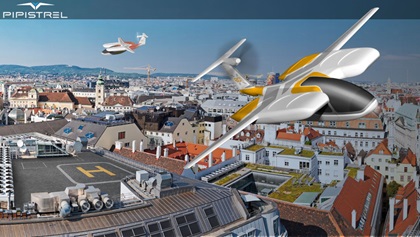 Pipistrel 801
Pipistrel 801
Pipistrel, based in Slovenia, has long specialized in electrically powered general aviation aircraft. The Pipistrel 801 was announced at the 2019 Uber Elevate Summit, although it has yet to fly. Its configuration is unusual in that it’s a winged design with a series of eight vertical fans set in the wing roots. For cruise flight, a single, rear-mounted propeller provides power; in cruise, doors cover the vertical fans to reduce drag. There are four battery packs, fly-by-wire controls, and the aircraft will be piloted initially. Ultimately, the 801 will fly as an unmanned vehicle.
Seats | 5
Range | 60 nm
Max cruise | 152 kt
Prototype first flight | 2022
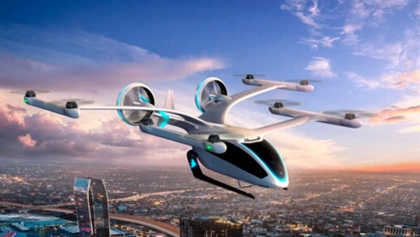 EmbraerX
EmbraerX
Embraer, the Brazilian manufacturer of airliners, military aircraft, and business jets, has branched out into eVTOL flight with its EmbraerX. It was introduced at the 2019 Uber Elevate Summit and has eight unshrouded vertical rotors and two large, shrouded, aft-mounted propellers for forward flight. Embraer plans to match the Uber specifications profile.
Seats | 4
Max TO weight | 4,000 lb
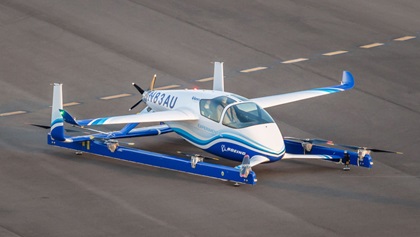 Aurora Flight Sciences PAV
Aurora Flight Sciences PAV
The prototype PAV (for Passenger Air Vehicle) has eight vertical motor/rotor units for vertical flight, mounted on a pair of skids. A single, aft-mounted unshrouded propeller provides thrust in cruise flight. Test flights have been conducted at Aurora’s Virginia location on the Manassas Regional Airport. Aurora is a subsidiary of the Boeing Company, and the PAV is part of Boeing’s NeXT urban air mobility organization—which is also testing a fully electric cargo air vehicle (CAV) capable of carrying loads up to 500 pounds. In June 2019, a PAV in an unmanned flight test crashed under unknown circumstances.
Seats | 2 to 4
Range | 47 nm
Max cruise | NA
Prototype first flight | January 22, 2019
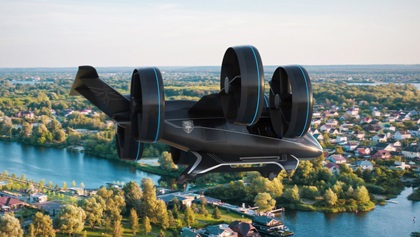 Bell Nexus
Bell Nexus
Bell’s eVTOL uses a hybrid propulsion system that teams a Safran turboshaft engine and gearbox with six large, battery-driven, ducted tiltrotors. Maneuvering will be controlled by Thales flight computers and Moog flight control hardware. It will be piloted initially, then the plan is to move to autonomous flight. A full-scale, nonflying mockup of the Nexus debuted at the 2019 Consumer Electronics Show in Las Vegas.
Seats | 5
Max TO weight | approx. 6,500 lb
Range | 130 nm
Max speed | 130 kt
Entry in service | mid-2020s
Other Designs
 Lilium Jet
Lilium Jet
This all-electric German design has 36 ducted motor/rotor units mounted within the trailing edges of its articulating canard- and wing-mounted combination flap and control surfaces. The speed of the motors and the angle of the control surfaces can be changed within one-tenth of a second for maneuvering. It has triple-redundant flight computers, retractable landing gear, and gull-wing doors. At maximum power, Lilium says that the engines produce a total of 2,000 horsepower, but only a tenth of that power is required for cruise flight.
Seats | 5
Range | 162 nm
Max cruise | 162 kt
First flight | May 4, 2019
67 dB: Uber's target noise level for a VTOL at 250 feet--comparable to a Prius driving at 35 mph, 25 feet away
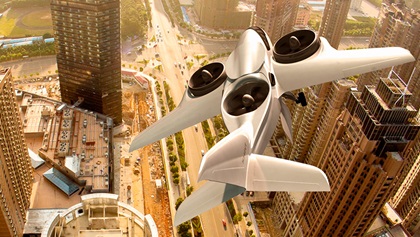 XTI
XTI
Extended Technology and Innovation, known as XTI, is offering a $6.5 million TriFan 600 aircraft capable of vertical takeoff using hybrid power. The carbon-fiber aircraft uses a turbine engine to drive three electric generators that power three electric fans. Certification is planned for 2023. It will carry four passengers with two pilots or five passengers and one pilot. The company has received deposits for 81 aircraft. A $25 million fundraising round is planned to build a full-scale prototype. A short conventional takeoff run (500 feet) will allow the aircraft to carry enough fuel for a 1,200 nm trip. A vertical takeoff will drop the range to 670 nm. 65-percent scale model tests are in progress. —Alton K. Marsh
Powerplant | GE Catalyst engine, 1,300 shp, drives three generators that power electric motors
Seats | 6
Max payload | 1,800 lb
Anticipated cruise speed | 300 kt
Max range | 670 nm to 1,200 nm depending on whether vertical takeoff is used
 Alaka’I Technologies Skai
Alaka’I Technologies Skai
The Skai is unusual in that it’s powered by an environmentally friendly, liquid-hydrogen-based system that generates electricity via conversion of its gas in a fuel cell containing a platinum screen. It has six unshrouded rotors, a ballistic emergency parachute, and Alaka’I says the hydrogen fuel cell can store more energy in less space than conventional batteries. The fuel cell is also 95 percent reusable and 99 percent recyclable and has a 20,000-hour life cycle.
Seats | 5
Useful load | 1,000 lb
Max speed | 103 kt
Max endurance | 4 hours
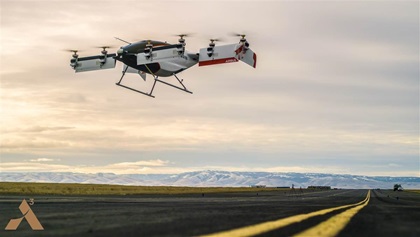 Airbus Vahana
Airbus Vahana
The Vahana, a single-seat technology demonstrator not intended for commercial use, is from A3, a Silicon Valley branch of Airbus. It’s a twin tiltrotor with four 45-kW (60-horsepower) rotors on each wing.
First flight | February 2, 2018, autonomous; 66 test flights as of June 2018, including transition flights
Max speed | 90 kt
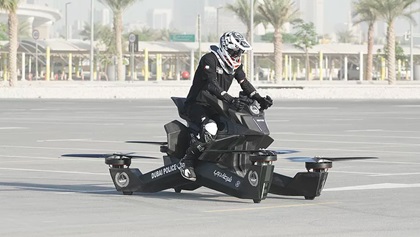 Hoversurf Hoverbike
Hoversurf Hoverbike
According to San Francisco-based Hoversurf, the Hoverbike is FAA-certified under FAR Part 103—the rules governing ultralight aircraft. The one-man vehicle is powered by three batteries that drive four unshrouded rotors. The company says one of its Hoverbikes currently is in use by the Dubai police force.
Price | $59,900
Seats | One
Weight | 229 lb (with batteries, 110 lb without batteries)
Range | Up to 11 nm
Max speed | 37 kt
Max endurance | 20 min
That’s not a reference to airplanes with electric motors mated to conventional-configuration airframes having fixed wings and horizontal and vertical stabilizers. Those designs—chiefly European ones such as the Airbus E-Fan, Magnus eFusion, and Pureflight Φnix—have already been demonstrated. Another one, Pipistrel’s Alpha Electro, is certified under European ultralight and experimental regulations—and as an LSA in Australia, New Zealand, and South Africa, and in the United States under an LSA exemption. The United States’ Bye Aerospace two-place eFlyer is projected to be certified under FAR Part 23 in 2020. Thanks to rechargeable lithium-ion batteries, all promise low operating costs. And thanks to their electric motors, all promise quiet and pollution-free operation, shunning fuel-guzzling internal combustion engines.
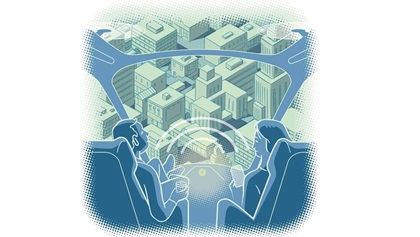 eVTOLs
eVTOLs
But another application of airborne electric power—eVTOL (electric vertical takeoff and landing) aircraft—is poised to influence urban transport. That’s where the true revolution appears to be in the offing.
Make no mistake: The burgeoning crop of eVTOLs was inspired by drones. Some 15 years ago, easy-to-fly, camera-equipped drones with stabilization and GPS navigation systems burst on the scene and instantly became must-have playthings. Then their numbers swelled and drones filled more traditional roles as vehicles for surveillance, wildlife management, law enforcement, and military uses. They went from toys to legitimate functions almost overnight. Along the way, they inspired visionaries who saw drones as the germ of even grander ambitions.
By 2014 the eVTOL idea began to gel in Europe. At that year’s Aero Friedrichshafen show I saw one of the more prominent examples: the Volocopter. With its two-place pod slung under a large circular array of 18 rotors and nine motors it seemed somewhat comical at the time. However, company president Florian Reuter was talking about the Volocopter as a kind of flying taxi. Now we can see that the Volocopter was ahead of its time. It was a portent of an industry to come.
Today there are scads of eVTOL designs. Some estimates put the number at more than 150, and counting. Bear in mind that many of those designs have never flown. They exist only on cocktail napkins, drawing boards, or company websites. They range from the downright whimsical (one-man “hover bikes” that mimic Star Wars’ forest speeders) to winged tiltrotors (like miniature V–22 Ospreys), to those that resemble flying saucers with ducted fans (Vertical Aerospace’s eVTOL)—and seemingly everything else in between. There is even a design with 36 motors and rotors embedded in its flaps’ articulating trailing edges (the Lilium Jet), and another powered by hydrogen cells (Alaka’i Technology’s Skai). But almost all of them have elements in common: They take off and land vertically; their multiple rotors have small diameters; they use lithium-ion batteries for power; and as a result of the latter have limited useful load, range, endurance, and speed. In addition, their lithium-ion batteries can take a long time to fully recharge, may experience thermal runaways, and can catch fire if damaged. Even so, battery technology is steadily making improvements in endurance, and modern on-board monitoring and management systems can isolate misbehaving battery cells, keep voltages under control, issue warnings of impending runaways, and prevent fires. Meanwhile, protective cases guard against physical breakage.
Enter Uber
As the eVTOL movement grew it began to attract attention beyond the in-crowd of early designers and enthusiasts. With so much eye-catching innovation, it wasn’t long before mainstream industry got on board, lest it seem oblivious or self-content. Companies such as Bell, Boeing, and Embraer felt pressured to get in on what seemed like viable future opportunities. They tasked small teams with creating their own visions of an eVTOL future.
The game changed by 2016, when ride-sharing service Uber announced it was endorsing its own vision: nationwide inter-urban networks of eVTOL flying taxis, shuttling passengers quickly and efficiently across cities clogged with traffic jams. It published a 97-page white paper outlining how its on-demand air service would operate, and filled it with examples and reasons why such a service would thrive. Then came a major outreach and publicity effort.
The Uber Elevate initiative was born. In April 2017 the first Uber Elevate Summit was held in Dallas—one of the first three launch cities targeted for its eVTOL air taxi service (the others are Los Angeles and Melbourne, Australia). Participants included 72 industry and government experts, along with newly named Uber Elevate partners Embraer, Karem, and Pipistrel—each of which provided mock-ups of their candidate designs for Uber service.
By the third summit, held in Washington, D.C., in June 2019, there were 1,200 participants, and Aurora Flight Sciences (a Boeing company) and Bell joined as partners. An additional 12 partners were named to provide input on infrastructure issues such as battery charging, motor and battery technology, and consulting services for landing site (Uber calls them “Vertiports”) development.
Uber Elevate conferred instant validity for the entire eVTOL concept. No longer would eVTOLs dwell in the shadows. If the experts at Bell, Boeing, Embraer, and Pipistrel are committed to an eVTOL future, and with Uber at the helm, the way seems clear to new standards of air travel. That’s not say there won’t be challenges—for both the Uber concept as well as eVTOL manufacturers and individual pilots taking up this new form of general aviation flying.
Aircraft design factors
All of the principals in the eVTOL community are aware of the unknowns in putting these aircraft in service. Tethered flights have been conducted. The problem is that the manufacturers have yet to fly a manned, full-scale eVTOL that conforms to a final, certified design.
This brings up the issue of certification. No eVTOLs have been certified as of this writing, and moreover it’s unknown which—if any—certification standards would apply to these aircraft. Remember, these aren’t drones. They are aircraft that will be flying pilots and passengers. In the case of Uber flights, paying passengers. Would rotorcraft certification standards apply? This seems like it might be a proper path, but the propulsion configurations—especially those with tiltrotors—and light rotor loadings in vertical flight might necessitate a new, unestablished certification category. Would eVTOLs flown for hire require certification for flight in instrument conditions? You’d think so. Icing conditions? Seems reasonable, given all those small rotors and high-drag or articulating airframes. And yet, no certification standards have so far emerged.
Uber Elevate conferred instant validity for the entire eVTOL concept. No longer would eVTOLs dwell in the shadows.Other issues include an eVTOL’s behavior in gusts. This should call for extensive flight testing in a variety of wind conditions. Uber’s plan is to establish its vertiports on the flat roofs of taller structures in a city environment. Given the mechanical turbulence produced by any nearby structures and an eVTOL’s presumably lighter weights, wind shear might well be a routine event. Will there be enough control responsiveness and effectiveness to allow safe hovering in high winds with shifting speeds and directions?
Uber has said that its air taxi system will enter service in 2023. Can the eVTOLs in its fleet meet type certification standards in three short years? For that matter, can their manufacturers secure a production certificate for their production procedures and assembly lines in that time frame?
There would also be function and reliability tests—for all eVTOLs, not just those in the Uber fleet—to assure that the aircraft performs consistently over time. Finally, there is the battery issue. Pilots need to know how long any batteries should last, so this means manufacturers should test them on the aircraft, in a number of environmental and flight conditions, as yet another part of flight envelope definition. Can all the above be completed successfully in three years? There is reason for doubt. Some manufacturers acknowledge as much, saying that 2028 might be a more sensible date for completing test and certification hurdles.
Until certification standards are established, the Uber Elevate concept cannot proceed. Nor can any individual pilots fly eVTOLs—unless, perhaps, under Experimental category provisions.
In Europe, the certification issue has already been addressed. In July 2019 the European Aviation Safety Agency (EASA) set out its final Special Condition for VTOL aircraft (SC-VTOL), which do not fit any existing certification categories. The SC-VTOL rules apply to aircraft seating up to nine passengers, weighing up to 7,000 pounds, with distributed propulsion—defined as having two or more lift/thrust units. This sounds reassuring, but compliance standards still need to be developed. Then harmonization with FAA rules can begin.
To date, the FAA has said only that eVTOL certification standards will vary with each design, and be issued under special conditions somewhere between existing FAR Part 23 (fixed wing) and FAR Part 27 (rotary wing). But no details have been forthcoming.
Private pilot—eVTOL?
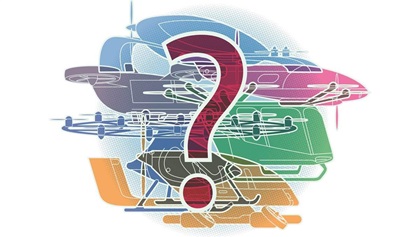 Pilot certification and training also must acknowledge the eVTOL’s unique position. An Uber white paper says that the popularity of eVTOL transportation will create a pilot shortage, then goes on to imply that commercial pilot training to FAR Part 135 standards would suffice. That’s pretty superficial thinking. What’s more likely is that a new set of certification standards will have to be developed, meaning training and testing tailored for the new batch of ATP, commercial, or private eVTOL pilots.
Pilot certification and training also must acknowledge the eVTOL’s unique position. An Uber white paper says that the popularity of eVTOL transportation will create a pilot shortage, then goes on to imply that commercial pilot training to FAR Part 135 standards would suffice. That’s pretty superficial thinking. What’s more likely is that a new set of certification standards will have to be developed, meaning training and testing tailored for the new batch of ATP, commercial, or private eVTOL pilots.
Civilian pilots will need to be trained for such flight regimes as those involved in tiltrotor operations, for example. With winged tiltrotors, the transition from vertical to horizontal flight, and vice versa, can be fraught—especially in gusty conditions. Asymmetric wing stalls could cause a loss of control.
Then there is the issue of flight in instrument meteorological conditions. Unless Uber plans on VFR-only air taxi operations, pilots will need—at minimum—commercial pilot certificates with instrument ratings. And vertiports will need instrument approach procedures.
It may be that each eVTOL may require its own type rating of sorts, given the wide variety of designs and propulsion schemes. But again, to date there has been no formal progress in this area.
Airspace and ATC
Uber’s plans involve intracity travel to designated vertiports, using its own routes that use GPS fixes. This would require air traffic control for sequencing and separation of flights, but with a special emphasis on the airspace below 1,000 feet agl. Embraer put out a white paper—Flight Plan 2030—that expands on eVTOL air traffic control, suggesting that current government-run ATC services may not be well-suited for eVTOLs. Instead, each city or nation could have its own Urban Airspace Service Providers (UASPs) that would serve the en route phases of flight; separate Urban Air Mobility (UAM) providers would manage skyport/vertiport arrivals and departures.
What’s not mentioned is the need for surveying and charting this low-altitude environment for obstacles and clear signal reception at a very dense scale. These charts would then be used in the cockpit on a multifunction or other electronic display, along with digital weather information.
Both Embraer and Uber hint strongly that air traffic control services could be a privatized function, run by Uber itself or some other nongovernment provider. If this path is taken then the private service providers will most likely need to coordinate air traffic flows with an already-established government-run ATC, especially in urban areas served by existing airports. Conventional air traffic may use arrival or departure corridors that cross the routes used by eVTOLs. Helicopter traffic will also use the same airspace as eVTOLs, and so would package-delivery drones if current projections hold up.
If eVTOL traffic counts rise outside of urban areas, then presumably the current ATC system would handle it. But given that eVTOLs operate primarily in low-altitude airspace, ATC surveillance radars may not always be able to detect and separate them.
Embraer’s idea of a typical urban flight would begin with a flight authorization—a slot—for an eVTOL departure issued to the pilot, who then takes off into a cruise segment. En route, a cooperative arrangement of on-board traffic detection and UASP surveillance monitors the flight—which follows GPS-defined legs—and looks out for traffic and adverse weather. Any messages to the cockpit are sent via digital messages (like today’s controller-pilot datalink communications technology). Skyport/vertiport personnel clear the eVTOL to land, ensuring that there are no weather or other hazards, and assigning a specific landing pad. After landing, the pilot sends a confirmation of landing, which is shared with all network users.
Me—fly in that?
It’s exciting to think about the possibilities of eVTOL flight, especially the airborne UberX idea. Who wouldn’t trade an hour’s drive in stop-and-go traffic for a 15-minute flight above it all? And what pilot wouldn’t like to cruise, nap-of-the-earth style, over beautiful scenery in his or her own eVTOL? It’s safe to say that the demand is there, but the level of that demand is a question mark.
Major unknowns lurk over eVTOLmania, which is currently in its youthful-exuberance phase. Battery endurance still leaves a lot to be desired. Uber says its flights should land with battery reserves equal to 30 minutes of flight time, like today’s VFR fuel reserves—but current lithium-ion batteries may last only 30 minutes. Vertical takeoffs draw huge amounts of electrical power, and precious little may be left for the rest of a flight. Battery technology has made big strides lately, but it has to come even further to make eVTOLs practical.
Those vertical takeoff and landings are also noisy. The noise is of a high frequency, quite unlike the low-frequency noise made by helicopters. Most dislike higher-frequency noise, so eVTOL operations may be a big nuisance for many neighbors. And passengers.
This brings up the biggest potential roadblock of all to mainstream eVTOL flying: public acceptance. To most, they look fragile and sound drone-like. They are new and fanciful-looking, like something a 10-year-old would draw. The average individual becomes concerned at the thought of flying in one. Is it safe? they think. Uber says that eVTOLs need to be safer than driving a car on a fatalities-per-passenger-mile basis. Is that reassuring? Perceptions are often based on gut-level reactions. Yes, the earliest of early adopters will sprint to eVTOLs, cash in hand. As for the rest of us, we’ll wait and see: eVTOLs will only achieve broad success if pilots and passengers perceive that they have a level of safety equivalent to that of certified aircraft.
Even with that assurance there will be skeptics. Uber—which is setting the trend so far—states that its ultimate goal is autonomous flight. That means completely automated flight, from takeoff to landing, with no pilot aboard. Now imagine John Q. Public stepping aboard a craft about to cruise above a city. Inside are four seats, and a pilot nowhere in sight. Will he trust the automation, or turn around and leave? The future of intra-urban eVTOL air taxis rides on the answer.
Email [email protected]



